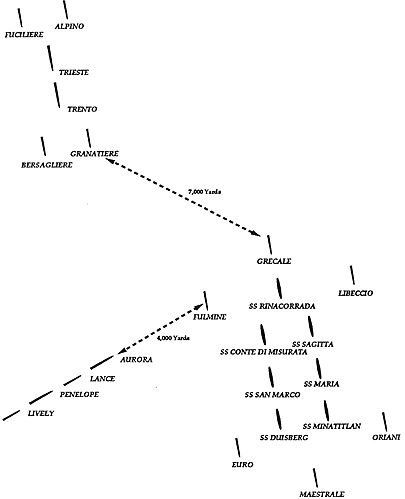INTRODUCTION
In the spring of 1941, at the personal direction of Prime Minister Winston Churchill, a small striking force of surface ships was established at the naval base in Malta's Grand Harbor. Designed to interdict the flow of supplies to Rommel's Afrika Korps in North Africa, the Malta Striking Force (which was designated Force 'K" by the Admiralty) quickly began to achieve results. Initially composed of fleet destroyers, they worked closely with the bombers and submarines also based at Malta to destroy the numerous convoys plying the shipping lanes between Italy and North Africa. On one particularly successful night (16 April, 1941), Force 'K' sank eight ships from a convoy, for the loss of only one British destroyer, H.M.S. Mohawk.
Though driven out of Malta by the continuous aerial bombardment that summer, Force 'K' was reestablished at Malta in the fall of 1941 with the basing of a small cruiser/destroyer force. Composed of a pair of cruisers and destroyers respectively, it quickly developed into one of the most effective units in the history of the Royal Navy. Alerted by Allied intercepts of German naval "Enigma" cipher traffic (know as the ULTRA secret), as well as the breaking of Italian naval codes, Force 'K' was set to pounce on any Axis shipping traffic that might come its way. On the night of 8/9 November, 1941, it sortied to intercept a critical convoy of supplies to North Africa. Guided by Wellington scout bombers (equipped with ASV air-to-surface radar), it intercepted the convoy shortly after midnight.
LOCATION
150 miles East-Northeast of Malta (37 degrees 00' North, 18 degrees 10' East), 9 November 1941, 0050 Hours Local (GMT minus 4).
OPERATIONAL SITUATION
An Italian supply convoy bound for Tripoli is intercepted by the British Force K operating from Malta. The British have advance warning from "Ultra" intercepts of German and Italian naval codes, and excellent air recon.
TACTICAL SITUATION
The Italian convoy (known alternatively as the "Beta" or "Duisburg" Convoy) of seven Ships (German and Italian) is steaming is two columns, with a close escort force of six Italian destroyers. A distant Italian covering force of two heavy cruisers and four destroyers is steaming a zigzag course four thousand yards astern of the convoy. With the help of radar, the British force of two light cruisers and two destroyers has maneuvered into firing position undetected, achieving tactical surprise at a range of only 4,000 yards.
ENVIRONMENT
Wind NNW Force 3, Cloud: one tenth cumulus, nine tenths light cirrus, sea and swell 21, visibility very good ( 20,000 yards - Aurora sighted the convoy at a range of 16,000 yards). 3/4 moon bearing 100 degrees, 45 degrees above the horizon. Sunrise at 0619 Hours Local Time.
AXIS FORCES
A convoy with close escort and covering force as follows:
Close Escort (Captain Bisciant):
- Maerstrale Fulmine Grecale Libeccio (all Maerstrale class), Oriani (Oriani class), Euro (Turbine class).
Convoy:
- Tankers Conte di Misurata (5,014 t.) and Minatitlan (7,599 t.), Transports Duisburg (7,389 t), San Marco (3,113 t), Maria (6,339 t), Sagitta (5,153 t), Rina Corraldo (5,180 t).
Covering Force (Admiral Brivoncsi):
- Trento, Trieve (Trento class), destroyer squadron (Captain Cappord): Granatiere. Fuciliere. Bersagliere, Alpino (all Soldati class).
AXIS ORDERS
Protect the convoy, and proceed South as far as possible by daybreak.
AXIS VICTORY CONDITIONS
Decisive: no tankers and no more than ten thousand tons of transports sunk or disabled (50% damage or more) at the end of the scenario.
Tactical: At least one tanker and 15 thousand tons of transports still operational at the end of the scenario.
ALLIED FORCES:
Force K (Captain Agnew):
- Aurora; Penelope (Arethusa class, second group), Lance, Lively (L class).
ALLIED ORDERS
Intercept the convoy and sink or disable the tankers (top priority) and transports.
ALLIED VICTORY CONDITIONS
Decisive: sink or disable (50% damage or more) both tankers and at least 15000 tons of transports.
Tactical: sink or disable at least one tanker without the loss of any ship. Any other result is considered a draw.
SETUP
Italian convoy and close escort steaming at 9 knots, course 170 degrees Covering force at 12 knots, course 170 degrees. British force at 20 knots, course 095 degrees, in line ahead Aurora (Flag), Lance, Pendope. Lively). See map for initial positions.
SPECIAL RULES
The Allied player can acquire, target and fire on any ship(s) in the convoy force (only) on the first turn.
HISTORICAL OUTCOME
All seven ships of the convoy and the destroyer Fulmine were sunk. Euro and Grecale were damaged, and Libeccio was sunk the next day by the British submarine Upholder while rescuing survivors. Admiral Brivonesi and Captain Bisciani were relieved of command. No British ships were damaged, and all returned safely to Malta. Captain Agnew was knighted, and the Admiralty ordered Agnew to have his crews, "...splice the mainbrace..."
MAP

More Beta Convoy November 8, 1941
BT
Back to The Naval Sitrep #1 Table of Contents
Back to Naval Sitrep List of Issues
Back to MagWeb Master Magazine List
© Copyright 1994 by Larry Bond and Clash of Arms.
This article appears in MagWeb (Magazine Web) on the Internet World Wide Web.
Other military history and related articles are available at http://www.magweb.com